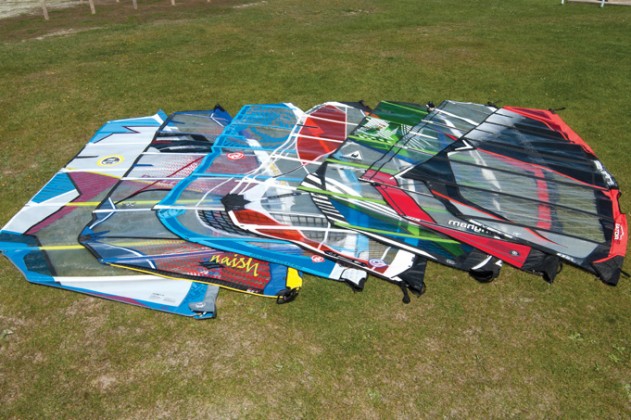6.5M NO CAM FREERIDE SAILS TEST REVIEWS
(This feature appeared in the June ’13 issue of Windsurf Magazine. Print and digital subscriptions are available here.) Report by Iain Hunter Pic Mark Kasprowicz
To go alongside our freeride board reviews, we tested some 6.5, no-cam freeride sails designed to power larger, wider intermediate and freeride boards.
As with the boards examined in this issue, the target user is the improver/novice/intermediate or more experienced sailor who might use one as an inland water ‘change-down’ rig or crossover freestyle/wave option. The key to these sails is user-friendliness and so those seeking easy rigging, lighter weights for uphauling and waterstarting, easy rotation and the low-end power that encourages planing in lighter winds will benefit most.
TRENDS
With the specific aim of being easy to use there are two main observations as to the progression of this sail class. Firstly, all bar one of these sails sit on a 430 mast and all bar one (not the same one) feature a clew cut-out/dropped clew which shortens the length of the boom. These two factors give a more compact feel and a lower, more concentrated centre of effort helping to control the wider boards and making the sail easier to handle particularly in manoeuvres. Secondly, nearly all appear to rig with one optimum downhaul setting and promote fine-tuning through outhaul alone. For the novice this is a great feature, the amount of people I see on the water with insufficient downhaul is staggering but with pretty much one correct recommended downhaul setting, it removes a critical variable that can potentially ruin what could have been a great session. In fact, the North Natural comes with a new VTS Plus system that gives accurate luff and boom measurements and claims you can set these and go in almost any conditions. We tested this and found it pretty much on-the-money. This is great news for everyone in general because, let’s be honest, with time against us and adrenaline in our veins, how many of us can be bothered to adjust the downhaul unless we find ourselves really over or underpowered? Outhaul is a much easier adjustment to make and as little as +/- 1 cm makes all the difference.
TESTING SET-UP
We used these rigs on the freeride boards in the same location and conditions as featured in this issue’s board test (see board test introduction), but also on some smaller freerace boards in higher wind. Coupled with a bunch of different size sailors of differing abilities and style, the sails have been used in a wide variety of conditions to give us a great amount of information. As with the board test we rigged the sails and went out on the water before taking a detailed look at shape and construction. To begin with we rigged the sails with near-maximum downhaul and only tuned the outhaul particular to the conditions. In fact this was a great decision as our main discovery was just how much difference a little bit of outhaul adjustment can make to the feel of the sail. Only when things got really hairy or really marginal did we adjust the downhaul. Once again we noticed how some sails suit particular boards (higher aspect sails tend to like more stretched board outlines and compact sails like all boards!) or types of sailing so read on to discover which might suit you best.
HARDWARE
As is often mentioned in the sail tests, we used the manufacturers recommended masts and this is always a good idea. It’s not ‘compulsory’ to use the specific brands’ spars but the correct IMCS and length are critical as these bend characteristics will enable the sail to work most efficiently, twisting away to release a gust and springing back to maintain a regular pull. They’re the masts the sails are developed on so it makes sense to choose the best possible option you can. If not, try some out at your local dealer on both the recommended and your own masts and see what suits you best. We used North Silver booms on each rig set-up with an adjustable outhaul for quick and simple tuning. When you buy a new sail it’s worth checking if the tack pulley/eyelet is compatible with your current extension. Most sails feature a roller pulley but are often designed to work with their own make of extension but not necessarily with the others, therefore, for example the Naish and Severne tack pulley system might not work with, say a North mast extension. We can see why they do it (I call it ‘Apple syndrome’), but wouldn’t it be just wonderful for the consumer to have cross-brand-compatibility?
FINDINGS
You’ll notice in these individual reports that some sails are at the racier end of the spectrum – Gaastra Matrix, RRD evolution, Severne Gator – and some more forgiving – the North Natural, Naish Rally, Goya Nexus and Tushingham Concept, which specialises in powering larger improver boards in lighter wind.
As you make up your mind try to think about whether your priority is learning and improving rapidly, or whether holding onto the sail longer term and more performance is your focus. Enjoy! IH
READ THE INDIVIDUAL REPORTS – to be released over the coming weeks.
Gaastra Matrix 6.5
Goya Nexus 6.4
Naish Rally 6.4
North Natural 6.6
RRD Evolution 6.4
Severne Gator 6.5
Tushingham Concept 6.5


